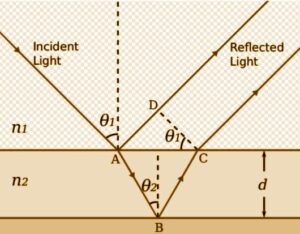Table of Contents
Thin-film interference
Introduction
Light waves bounced by the upper and bottom limits of a thin film interfere with each other, either amplifying or diminishing the reflected light.
A brief outline
The many hues are seen in light reflected from soap film and oil layers on the water are explained by thin-film interference. It’s also the process that makes antireflection coatings on glasses & camera lenses work.
Important concepts
When light hits the boundary between two media during interference, some of it is reflected and some are transmitted. When the second medium is a thin film, two reflections occur near each other at the thin film’s top and bottom boundary surfaces. As an outcome, two waves emerge from a thin film: one bounced off the film’s top surface and another reflected off the bottom surface.
Meanwhile, these characteristics influence the type of interference that can occur.
- The incident light’s wavelength and angle.
- The film’s thickness is measured in millimetres.
- Material refractive indices on both sides of the film.
- The film medium’s index.
The difference in Phase and Difference in Path
The phase difference between the two waves is the change in phase angle. The difference in actual distance covered by the two waves is known as path difference. The phase angle is a proportion of a full-wave cycle expressed as a fraction of 2 (360 degrees), — in other words, the phase difference between one wave peak and the next is 2 degrees (360 degrees).
The phase difference between the two reflected light waves determines whether the interference is constructive or destructive, resulting in an increase or decrease in the intensity of the reflected light. The intensity of light of a certain wavelength increases during constructive interference, while it drops during destructive interference. The phase shift is zero when light travels from a denser medium to a rarer medium. The phase shift is 180 degrees as light travels from a rarer medium to a denser medium.
Significance of thin-film interference in IIT JEE exam
The Oscillations and Waves chapter, which accounts for 10% of the exam questions, covers a wide range of topics. All you have to do is grasp the concepts of each topic. If you adhere to this course, your Physics training will be spot on, and you’ll be able to pass this section with flying colours. Thin-film interference will be the subject of 3 to 4 questions.
FAQs
Is it possible to have interference without diffraction?
In the case of thin-film interference, the interference phenomena occur without diffraction.
What are the Interference Conditions?
Knowing the source of the light is very significant for determining thin-film interference. A monochrome or broadband source could be used.
Why Does a Film with An Extremely Thin Uniform Thickness Appear Dark In A Reflected System?
Due to the interference of light waves in the medium, a thin film of uniform thickness will look black in the reflected system.








